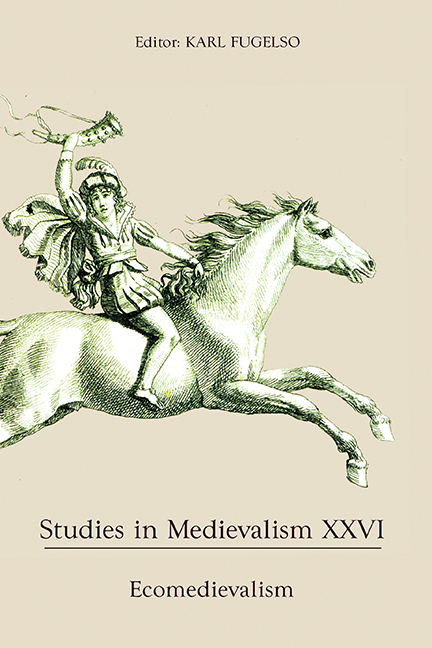Book contents
- Frontmatter
- Studies in Medievalism
- Acknowledgments
- Contents
- List of Illustrations
- Editorial Note
- I Ecomedievalism: Some Perspective(s)
- II Interpretations
- Fragmentary Dreams: John Aubrey's Medieval Heritage Construction
- Charter Horns and the Antiquarian Imagination in Early Modern England
- Giving Voice to Griselda: Radical Reimaginings of a Medieval Tale
- Medieval and Futuristic Hells: The Influence of Dante on Ellison's “I Have No Mouth and I Must Scream”
- Reading Westeros: George R. R. Martin's Multi-Layered Medievalisms
- Modernity in the Middle: The Medieval Fantasy of (Coopted) Feminism in Disney's Maleficent
- Future Medieval: (Neo)Medievalism in Babylon 5 and Crusade
- Cosmopolitan Anxieties and National Identity in the Netflix Marco Polo
- Mapping Everealm: Space, Time, and Medieval Fictions in The Quest
- Medievalisms of the Mind: Undergraduate Perceptions of the “Medieval” and the “Middle Ages”
- Mask of the Medieval Corpse: Prosopopoeia and Corpsepaint in Mayhem's De Mysteriis Dom Sathanas
- Contributors
- Miscellaneous Endmatter
Modernity in the Middle: The Medieval Fantasy of (Coopted) Feminism in Disney's Maleficent
from II - Interpretations
Published online by Cambridge University Press: 15 September 2017
- Frontmatter
- Studies in Medievalism
- Acknowledgments
- Contents
- List of Illustrations
- Editorial Note
- I Ecomedievalism: Some Perspective(s)
- II Interpretations
- Fragmentary Dreams: John Aubrey's Medieval Heritage Construction
- Charter Horns and the Antiquarian Imagination in Early Modern England
- Giving Voice to Griselda: Radical Reimaginings of a Medieval Tale
- Medieval and Futuristic Hells: The Influence of Dante on Ellison's “I Have No Mouth and I Must Scream”
- Reading Westeros: George R. R. Martin's Multi-Layered Medievalisms
- Modernity in the Middle: The Medieval Fantasy of (Coopted) Feminism in Disney's Maleficent
- Future Medieval: (Neo)Medievalism in Babylon 5 and Crusade
- Cosmopolitan Anxieties and National Identity in the Netflix Marco Polo
- Mapping Everealm: Space, Time, and Medieval Fictions in The Quest
- Medievalisms of the Mind: Undergraduate Perceptions of the “Medieval” and the “Middle Ages”
- Mask of the Medieval Corpse: Prosopopoeia and Corpsepaint in Mayhem's De Mysteriis Dom Sathanas
- Contributors
- Miscellaneous Endmatter
Summary
In 2014, Maleficent revisited the 1959 Disney animated classic Sleeping Beauty. An early production for the emerging company, Sleeping Beauty is foundational to the Disney corpus; it represents the values upon which the Disney kingdom is constructed. Maleficent, released over half a century later, signifies Disney's introspective turn toward its own heritage, a heritage rooted in medieval fantasy. Challenging audiences’ familiarity with popular fairy tales and the Disney corpus, the narrator proposes, “Let us tell an old tale anew, and we will see how well you know it.” Maleficent suggests a progressive, feminist conclusion that clashes with audiences’ present circumstances, rendering modernity a “dark age” by comparison. Maleficent is a revision that inflects the older Sleeping Beauty with contemporary social concerns and the emerging progressive values of a more inclusive Disney kingdom.
The film opens with two opposing realms: the moors, which are a dense natural realm inhabited by diverse mythical creatures, versus the kingdom, which is composed of bleak dingy spaces, dimly lit by fire, and inhabited by humans. Within the moors, young Maleficent, played by Isobelle Molloy, is a happy fairy dressed in earth tones, with a pleasant smile and playful nature. Her immense wings carry her over edenic spaces with breakneck speed. She is a healer, maintaining the health and well-being of the moors. But there is an intruder here. Stefan, a human boy, has ventured into the wilderness that his people typically fear. During their exchange, we learn two things: Stefan has attempted to take a stone from the moors as a token, and fairies like Maleficent are burned by the touch of ironworks forged by humans. Maleficent and Stefan cultivate a relationship that verges on romance, but they are eventually separated as Stefan grows older and is overcome by ambition. Fearing the mythical creatures, and seeking to commodify the natural realm, the king of the humans, Henry, launches an assault against the moors, which is vanquished by Maleficent, now played by Angelina Jolie. King Henry decrees that any subject who slays Maleficent will succeed him to the throne.
- Type
- Chapter
- Information
- Studies in Medievalism XXVIEcomedievalism, pp. 143 - 160Publisher: Boydell & BrewerPrint publication year: 2017

